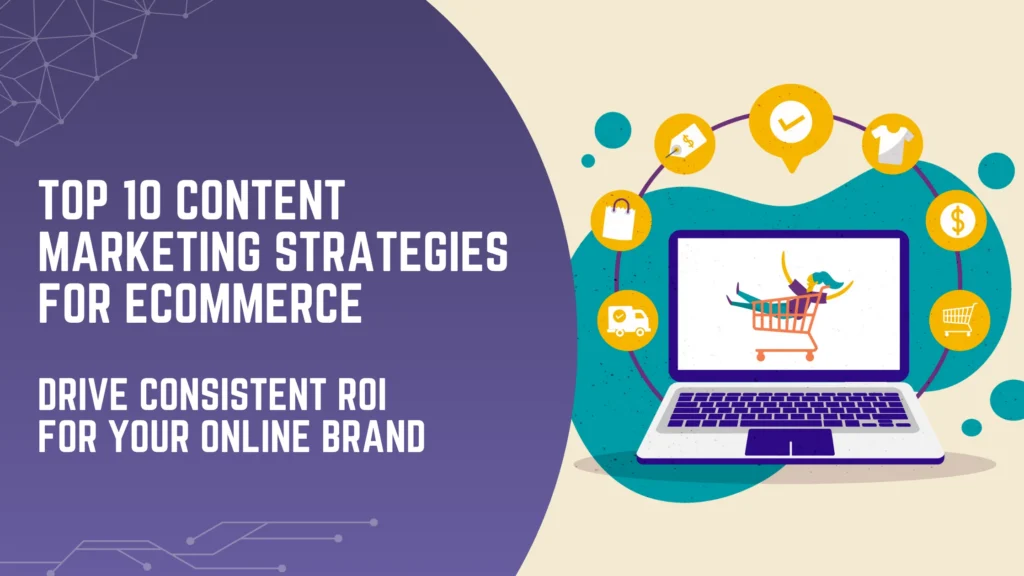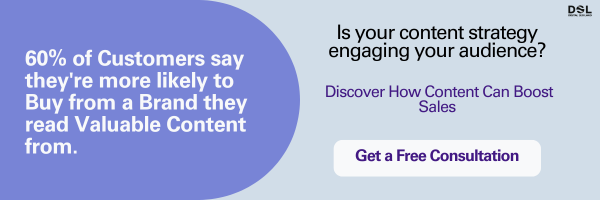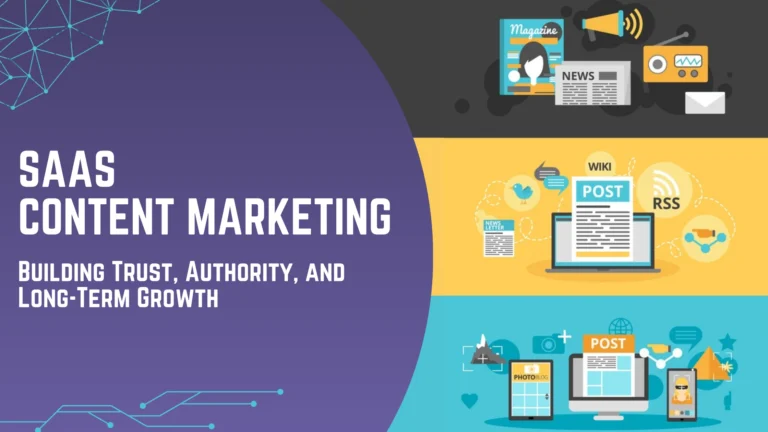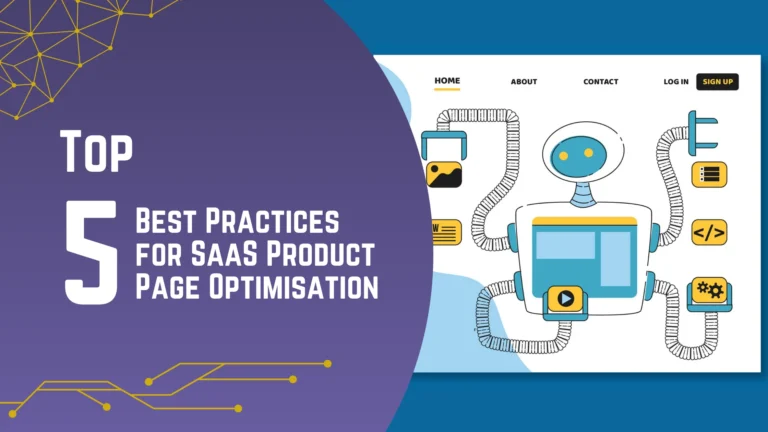Running a successful e-commerce business is all about winning the hearts of customers. Your business will automatically fall behind if you are not serious about creating a cross-channel content marketing strategy. After all, you want to engage as many shoppers as possible. With an effective ecommerce content marketing strategy you can address their specific needs. This will, in turn, ensure a smooth customer journey.
Let’s learn about what experts say about creating a content strategy for ecommerce website that pays off.
What is Content Marketing for Ecommerce Brands?
Consumers are always seeking something (that interests them) online. Be it a solution to a problem they are facing, entertainment, information on a specific topic, or more. So why not give them the answers or solutions they are looking for? That’s where content marketing comes to your aid.
Content strategy for e-commerce website is nothing but a framework designed specifically for your target market audience. An ideal marketing strategy should be curated to engage readers with helpful content instead of bombarding them with ads and sales pitches. Delivering quality content wherever your target market is works in your favor. Make sure you market your content on every channel possible – be it on search engines or social media platforms.You are where your customers are.
Content marketing for e-commerce brands means educating customers through relevant content. Constant marketing efforts can lead to boost organic traffic, customer loyalty & retention, and conversion.
Ecommerce content must be curated to deliver value to its readers. Video guides, good-quality images of your products, product reviews are some examples of ecommerce content.
What Type of Content Works Best for Ecommerce Industries?
The importance of content in the ecommerce market cannot be overstated. Your ecommerce website needs content that informs, engages, and persuades customers towards a purchase. Let’s learn the top content types that work well for ecommerce websites:
1. Compelling Website Content
Capturing your audience’s attention is no small feat. Successful ecommerce brands weave narratives that resonate on an emotional level. This helps them forge a connection that goes beyond a simple transaction. This is why creating compelling website content matters. Let’s discover the most effective content formats your audience would be drawn to:
- Videos: Product demos, explainer videos, and customer testimonials come alive through video.
- E-books are great at generating awareness, building trust & capturing leads.
- Checklists: Actionable steps for using products.
- Product Guides entail features & benefits of your products.
- Blog Posts: Informative & engaging content, improved SEO.
2. Content for Every Stage of the Buyer Journey:
a. Awareness Stage (Top of the Funnel):
Here, potential customers are just beginning their research. Informative content like blog posts, industry reports, and infographics educate potential customers about your niche.
According to HubSpot, companies that regularly publish content from their website generate 67% more leads per month than the ones that do not.
b. Consideration Stage (Middle of the Funnel):
Customers are actively researching solutions to their problems and evaluating available options. Create ebooks, product guides, and detailed product descriptions with high-quality images and videos. These resources address specific pain points and showcase how your products solve them.
At this stage customer testimonials and reviews work like a lead magnet to target new customers and help them decide whether to go forward with your solution.
Adding high-quality product videos to your website can increase conversion rates by up to 80%.
c. Decision Stage (Bottom of the Funnel):
Customers are ready to buy. Provide clear calls to action (CTAs), limited-time offers, and also social proof like customer reviews to nudge them towards making a purchase.
Strong CTAs can increase conversion rates by as much as 97%.
3. Brand Storytelling
A successful content strategy for ecommerce is incomplete without content that tells your unique story. By storytelling, you can give audiences the opportunity to learn about your brand’s core values.
Share stories of your founders, their values, and achievements. Customer stories are another helpful content type reflecting their challenges and how your products helped them solve the problem in the most optimal way.
4. Content That’s Relevant & Valuable
Content that educates audiences instead of commanding them to buy your products is of no help. Serving relevant content (wherever your audiences are) that educates them about how to use your products is the best way to win their hearts. It could be anything related to your product category or industry such as informational posts, how-to articles, tips & tricks, or shopping guides.
Make sure your ecommerce blog content strategies are compelling and optimized with relevant search terms. This helps improve your website SEO and the chances of you getting on the top of search engines.
5. Content with Social Proof Throughout Your Site
Reviews and ratings on websites and social media platforms have a key role to play. They help you create a loyal customer base and also build trust among new users. Sharing feedback from other users goes a long way in proving your brand’s authenticity and product’s applicability.
One of the most effective ecommerce social media content strategies is to interview happy customers. Use their stories to create interactive product videos and add them to your site. This type of content performs better than anything in the text form.
Guest posting and collaborating with influencers, blogging for your ecommerce website will do the trick too. As long as their reviews are authentic, building a strong reputation is a cakewalk for you.
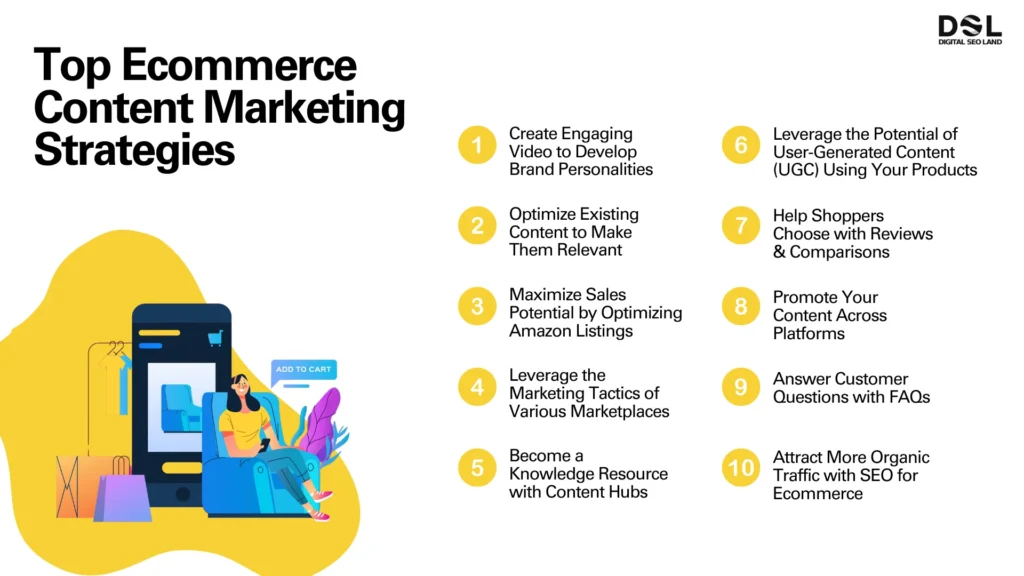
10 Best Ecommerce Content Marketing Strategies
The e-commerce market has fierce competition. No matter how efficient your product is, proper marketing is essential. This is where content marketing comes in. To thrive you need a strategy to create captivating content that informs, educates, and entertains. Here are the top 10 content marketing strategies you may try:
1. Create Engaging Video Content to Grow Your Brand Personality
The importance of video marketing cannot be overstated in the current ecommerce market. Videos attract more people compared to other forms of content. Product explainer & description, live shopping, and customer testimonial videos are good ways to connect with prospects. Behind-the-scene videos are also helpful. They give your audience a glimpse into your brand’s essence.
According to experts, audiences are more attracted to people than to products. For your e-commerce business to flourish, you need someone who has a ‘face’. Find someone with a charismatic personality to create engaging videos for channels like YouTube. This person will help spread awareness of your brand and its products or services, answer questions, and satisfy their needs on your behalf. This helps you generate more engagement, views, and conversions over time.
2. Optimize Existing Content to Make Them Relevant
Keeping content fresh and relevant is one of the most important strategies you can implement in 2024. Review existing content including product descriptions, blogs, and FAQs. Make sure there is no content that does not align with your target user base. Change product features (if needed), fix broken links, and include content according to the latest trends.
The next thing you can do is analyze your website traffic data. It gives you a clear picture of high and low-performing content. Take the time to improve those underperforming pieces of content.
Optimizing content for search engines is another useful content marketing strategy for ecommerce. Find out relevant search terms your target audiences use. Update existing content with these new-found keywords naturally without stuffing. Revise meta descriptions and make them more compelling. Include relevant keywords. This will allow you to rank your website higher on search engines, making it easier for buyers to find you.
3. Maximize Sales Potential by Optimizing Amazon Listings
More often than not people search for specific products on Amazon. If you have your products listed on Amazon then always remember to keep your product content on Amazon optimized and updated. This ensures buyers do not end up choosing your competitor within your product category. Amazon offers businesses various options to create content and optimize it over time. They include A+ content, and Amazon posts.
A+ content enables you to improve the quality of product descriptions. It lets you add features like high-quality pictures, videos, and more detailed text.
Also, focus on creating Amazon posts with interesting captions, imagery, and direct links to product pages.
4. Leverage the Marketing Tactics of Various Marketplaces
Take ideas from successful marketplaces that promote brands like yours. Ecommerce marketplaces are the go-to places where shoppers browse and purchase from a variety of brands. So why not participate in Amazon marketplace, Walmart marketplace, eBay, Alibaba, and more?
Tailor your content highlighting relevant products and promotions offered by the above-mentioned marketplaces during holidays. Some marketplaces run campaigns like Free Shipping Day. You need to create content using these events to gain the attention of a vast number of consumers.
5. Become a Knowledge Resource with Content Hubs
Develop content hubs with keyword clusters around specific themes or topics relevant to your products and target audience. This will help you establish yourself as a thought leader in your niche and attract potential customers looking for in-depth information before making a purchase.
Let’s say you sell camping gear. Your content hub could be “The Ultimate Guide to Camping Adventures.” Within this hub, create various blog posts, articles, and videos covering topics like backpacking essentials, choosing the right tent, campfire cooking recipes, or wilderness survival tips.
Content hubs shouldn’t be purely promotional. Include a mix of informative content, product reviews, buying guides, and even curated gear lists from experienced campers.
Ensure all content within the hub links back to each other and relevant product categories on your website. This improves user navigation and search engine optimization (SEO).
6. Leverage the Potential of User-Generated Content (UGC) Using Your Products
It’s a good idea to encourage your customers to share photos or videos using your products. Use this user-generated content to build trust. Run occasional contests and promotions that incentivize customers to share photos or videos using your products with a specific hashtag.
Showcase positive UGC on your product pages or email marketing campaigns to establish social proof. Respond to comments and show appreciation for customer participation.
7. Help Shoppers Choose with Reviews & Comparisons
Basic product descriptions no longer attract customers. People are more leaned towards researching before buying. And like you and me they will also look into the customer reviews no matter how much their product costs.
Incorporate customer reviews and comparison pages help customers make informed decisions everytime they make a purchase.
Integrate reviews from Trustpilot or Google Reviews onto your product pages. Ask customers to leave honest feedback. Create comparison pages highlighting key features of your products, specifications, and prices.
8. Promote Your Content Across Platforms
Don’t rely solely on your website to reach your audience. Actively distribute your content through various content distribution channels to maximize its reach and impact. Share blog posts, infographics, and videos on your social media platforms to reach a wider market. Encourage customer engagement with quizzes, polls, events, etc around your product niche.
Segment your email list and send targeted email campaigns featuring relevant blog posts, product recommendations, or special offers based on customer interests. Explore influencer marketing, guest posting opportunities on industry websites where you can share your expertise and link back to your content.
9. Answer Customer Questions with FAQs
Analyze customer service inquiries, social media comments, and online reviews to identify common questions and concerns. Based on this research, develop a comprehensive FAQ and help pages. Organize FAQs by category (Ordering, Shipping, Returns, Product Care) for easy navigation.
Include internal links to relevant blog posts, product tutorials, or troubleshooting guides within your FAQ pages.
10. Attract More Organic Traffic with SEO for Ecommerce
Optimize your website content and product pages with relevant keywords. This will help your pages to improve their SERP rankings. In turn you will get increased organic traffic and more potential buyers on your ecomm. website. Have a powerful SEO strategy from the beginning. Conduct targeted keyword research, optimize titles and metas, and produce quality content.
Always remember that, SEO is an ongoing process. Regularly analyze your website traffic and content performance to refine your strategy. Ensure your content remains relevant and competitive in search results.
Ecommerce Content Marketing Plan Examples from Known Brands
Northern Brewer (a homebrewing equipment seller) uses their website to educate potential customers about homebrewing. They offer informative articles (like “Homebrewing 101”), instructional videos, and interactive content marketing tools for ecommerce business (priming sugar calculator). This valuable content helps build trust. It guides customers towards relevant products, making the buying process smoother.
Another luxury swimwear brand Andie goes beyond just product descriptions. They provide detailed fit and style guides, even offering a personalized fit quiz. They create informative content to empower customers to choose the perfect swimsuit. Not only does it boost confidence but it also leads to conversions. Their product pages contain social proof through ratings and reviews.
Wrap Up
Today’s competitive market thrives with beautifully curated content marketing techniques for ecommerce. Marketing is not just about selling products, it is about building trust and relationships. Implement these strategies to establish your brand as a trusted source. Instead of monotonous sales pitches, try to come up with content creation ideas that resonate with your audience and help them lead a better life with your products.
Frequently Asked Questions
What is the role of content in ecommerce?
Content spreads awareness among potential customers. They educate, inform, and solve queries of customers and help them make informed decisions. The more people know about your brand through your content the more visitors your site will gain.
How can I measure the success of my content marketing efforts?
Measure your content marketing efforts through Website traffic, conversion rates, social media engagement, and sales generated from campaign data. Use Google Analytics to analyze these metrics.
What role does social media play in ecommerce content marketing?
Social media marketing helps you promote content and connect with larger audiences. It gives your brand the opportunity to interact with followers, answer questions, and run ads.
How can I create content that gets attention and leads to sales?
Create high-quality, relevant content that your target audience cares about. Solve their issues through valuable content. Your content should be appealing and easy to understand.
How can I use content marketing to launch and promote new products effectively?
Generate excitement with sneak peeks, and behind-the-scenes stories. Work with influencers and UGC to ensure your brand reaches a wider base of audience.
How can I tailor content marketing for my specific audience?
Audience research is a good idea. Identify their demographics and online behavior. Depending on that information, tailor relevant content that resonates with your prospects.

